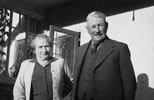Formation of the Farmers’ Union
At the end of the 19th century farmers began to form political groups, culminating in the setting up of the New Zealand Farmers’ Union. The first branch was constituted at Kaitāia on 1 September 1899, and the first national conference was in July 1902.
In 1905 the union promoted political candidates who would support farmers’ goals. In 1912 it helped oust the Liberals in favour of the Reform Party, headed by farmer William Massey. The Farmers’ Union eventually took over the political role of A & P associations, which subsequently became limited to organising annual shows.
‘Cossack’ farmers
The 1913 Wellington waterfront strike took place against a background of industrial unrest. Striking watersiders, after being locked out by their employers, took over the wharves. The Farmers’ Union organised groups of farmers, most of them on horseback, to converge on the ports. Prime Minister William Massey enrolled them as special constables to forcibly remove the strikers. This led to rioting, which was violently stopped by the police and ‘Massey’s cossacks’.
Political role
The Farmers’ Union motto was ‘principles – not party’, but inevitably it supported parties that shared its ideology. After backing Massey’s Reform Party, the union was rewarded with the 1912 and 1913 Land acts, which gave farmers on Crown leasehold land the option of purchasing it freehold. This had been a major issue for the union in the run-up to the 1911 election. The union also backed Massey during the 1913 Wellington waterfront strike, organising people to evict strikers who had occupied the wharves. By this time the Farmers’ Union was a national organisation. It published the Farmers’ Union Advocate from 1906 to 1924, and later Point Blank.
Formation of Federated Farmers
In spite of the clout wielded by the Farmers’ Union, rural political advocacy was not unified. The New Zealand Sheepowners’ Federation and other smaller producer groups tended to compromise farmer solidarity. In 1944 the Farmers’ Union and the Sheepowners’ Federation registered the name Federated Farmers of New Zealand. Their first provincial meeting was in 1945, and the next year they became an incorporated society.
Federation structure
Federated Farmers represents farmers from 25 regions. Its industry groups cover meat and fibre, dairy, goats, high country, rural butchers, grain and seed, and beekeepers. The Wellington office is responsible for policy, advocacy, lobbying and advisory services, and a president acts as the federation’s public face and spokesperson. In 2017 West Coast dairy farmer Katie Milne was elected as the first female president.
‘Fart tax’
In the early 2000s Federated Farmers fought a high-profile public campaign against a government proposal to impose a tax on farm animals to fund research into methane emissions from livestock. The federation called it a ‘fart tax’, and mounted such a strong campaign that the government scrapped the idea.
Political role
Federated Farmers lobbies the government on a variety of issues, including legislation affecting land, stock, taxation, local body legislation, employment regulations and environmental concerns.
In the early 2000s Federated Farmers opposed a government plan to microchip all dogs as part of a campaign to prevent dog attacks. They argued that microchipping farm dogs was costly, and the dogs were not in a position to attack the public. When the regulation came into effect on 1 July 2006, farm dogs were exempt.
Groundswell NZ
Groundswell NZ was founded in 2020 by two Southland farmers to oppose what they viewed as unworkable policies, including restrictions on winter grazing and emissions pricing. Groundswell has organised petitions, public meetings and tractor convoys to town and city centres. Its aims complement those of sector groups such as Federated Farmers.

